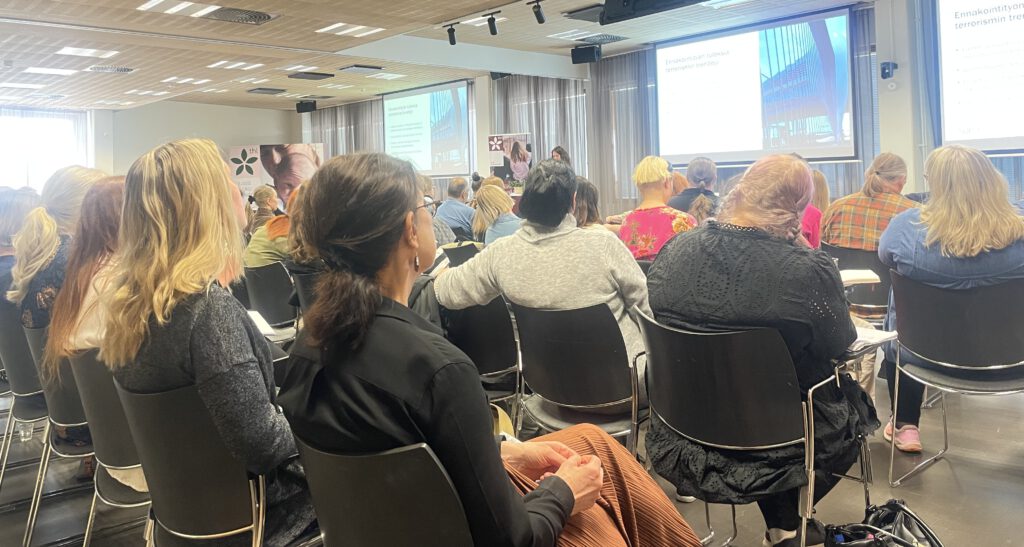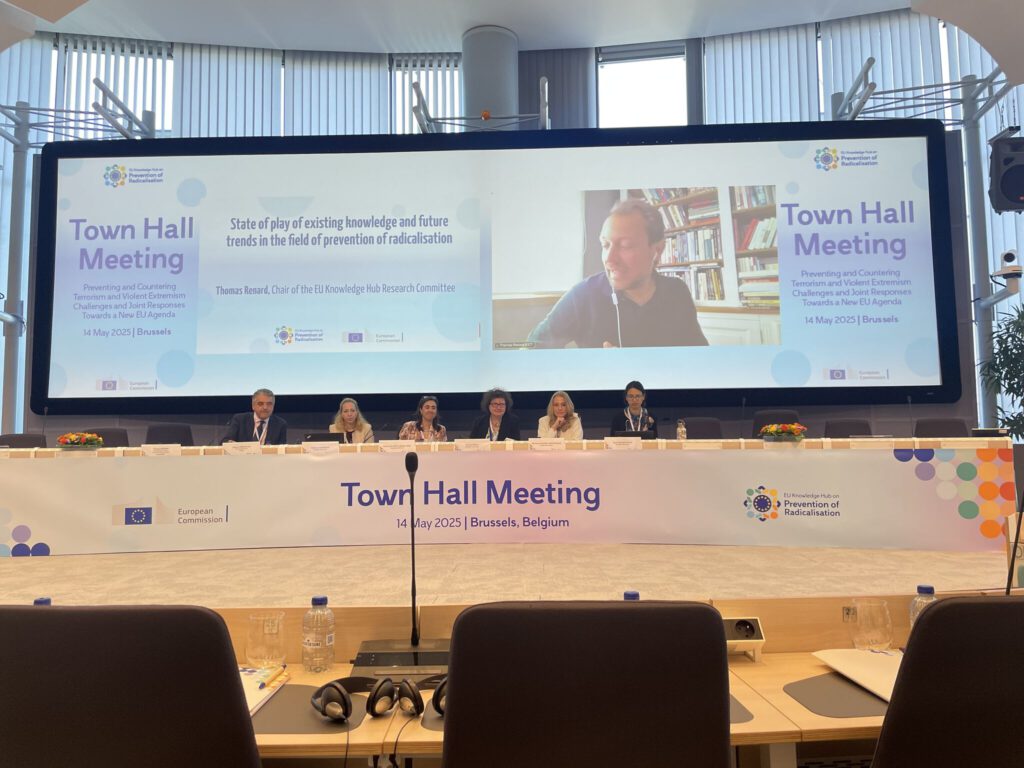By Fabian Wichmann – Presentation held on May 26, 2025, at the National Institute for Health and Welfare (THL) in Helsinki, as part of the expert conference “Where are we going? Radicalization situation and the new RADI2025 study”

Starting Point: Two Decades in Exit Work – A Personal Perspective
At this year’s expert forum hosted by the Finnish Institute for Health and Welfare (THL) in Helsinki, I had the opportunity to share insights from nearly two decades of work in the field of exit and disengagement— particularly focusing on the German context.
My professional journey began 19 years ago at EXIT-Deutschland, one of the first civil society initiatives in this field. There, I learned the foundations of structured, process-oriented exit work and understood how crucial biographical access and professional independence are to this work.
Over the years, I’ve been fortunate to share and deepen this knowledge through my involvement in the Radicalisation Awareness Network (RAN) of the European Commission and as co-leader of a working group in the EU Knowledge Hub (EUKH), the European network for radicalization prevention.
Today, I work for the civil society organization Grüner Vogel e.V., where we support individuals, especially young adults, coming from religiously motivated high-risk environments. Our work is biographically informed, resource-oriented, and firmly rooted in tertiary prevention.
What Does „Exit“ Actually Mean?
Exit work is about much more than simply leaving an extremist group. It is a deeply personal decision to break away from a worldview that has shaped one’s identity, thinking, and behavior for years. A successful exit requires critical self-reflection, coming to terms with one’s past, and a reorientation toward democratic values.
There are many reasons why people choose to exit: personal disappointment, burnout, feelings of emptiness, pressure from family, or simply the desire for a different life. Our task as professionals is not to push people out, but to walk alongside them. This takes time, trust, and a biographical — not just ideological — approach.
Specific Characteristics of the German Exit Landscape
The German context comes with its own unique framework. Germany’s historical responsibility after National Socialism continues to shape public awareness, especially around right-wing extremism.
At the same time, the country’s exit landscape is federally structured: all 16 federal states have civil society-led exit programs, complemented by government-backed services, often coordinated through domestic intelligence agencies or law enforcement. In addition, there are two programs operating nationwide, one led by a civil society organization, and one state-run, as well as several specialized initiatives addressing Islamist extremism.
Most of these efforts fall under tertiary prevention, meaning they work directly with individuals who are already radicalized. The goal is not only ideological disengagement, but also social reintegration and emotional stabilization.
In addition to right-wing and Islamist extremism, Germany also supports tertiary prevention projects in other ideological areas, including religiously motivated extremism beyond jihadist contexts, as well as exit support for individuals leaving sect-like groups or conspiracy-based movements. These programs reflect the evolving complexity of radicalization phenomena and respond to the growing ideological overlap across scenes.
To support this increasingly differentiated field, Germany has developed a structural framework of national working groups, including one focusing on right-wing extremism and another on religiously motivated extremism.
Currently, a consortium of civil society organizations is building what might be called a “mini-RAN” for Germany: a nationwide platform designed to consolidate resources, expertise, and practices from the field of tertiary prevention. The goal is to create synergies, facilitate knowledge exchange, and strengthen professional cooperation across ideological boundaries.
What Works – And What Doesn’t
What Works:
Effective exit work relies on core principles. At its center is the building of trusting relationships. Change doesn’t come through confrontation or lectures, but through reflection in a safe space. A biographical and resource-oriented approach helps uncover the true drivers behind radicalization — belonging, unresolved crises, or identity conflicts.
Multiprofessional teams, social workers, psychologists, educators, and when necessary, law enforcement, bring the needed diversity of expertise.
What to Avoid:
Entering ideological debates too early tends to trigger resistance. Pressure backfires. And stigmatizing or pathologizing clients closes doors before they’ve had a chance to open.
We are seeing ne w forms of radicalization, including conspiracy-driven hybrid scenes and the phenomenon of „Salad Bar Extremism“, where individuals mix ideological elements freely, regardless of consistency.
New Trends and Radicalization Patterns
We also see a worrying trend among young people and even minors. Radical content spreads rapidly online, often wrapped in humor, memes, or gaming culture. Adolescents may adopt extremist views before they even fully understand the social or historical context behind them. This requires us to rethink how we approach youth-specific exit and prevention work. And it goes even further: young people today are not just passive consumers, but increasingly creators and amplifiers of extremist content online. They engage actively editing videos, crafting messages, and shaping narratives. In addition, there is a strong dimension of self-presentation and a sense of mission expressed through social media. Extremist actions are no longer driven solely by ideology — they are increasingly performative in nature. Extremism becomes a form of self-staging, aimed at gaining attention, recognition, or reach within digital communities. Content becomes currency.
This shift requires new strategies. We must understand not only what young people believe, but how and why they express it online — and what role performance, identity, and digital validation play in the radicalization process.
Lastly, it’s important to highlight the growing involvement of women in extremist environments. This is often underestimated, but women are active not only as supporters or partners, but also as ideological leaders and recruiters. This underlines the importance of developing gender-sensitive approaches, both in how we understand pathways into extremism and how we shape exit strategies.
Structural Challenges
There are also significant structural and psychological barriers. Digital platforms amplify closed echo chambers and encrypted communication. Transnational networks make local prevention efforts more difficult.
Many individuals considering exit fear pressure or retaliation from their communities. Trust in institutions, state, media, even social services, is often deeply eroded. Meanwhile, professionals in this field experience emotional strain, as the work is intense, long-term, and psychologically demanding. That’s why exit work needs more than conviction — it needs reliable structures: supervision, team support, and long-term funding.
Opportunities and Strategic Recommendations
There are real opportunities we should be using. We must strengthen prevention networks, start earlier, expand political education and digital literacy, and invest in resilience-building. Above all, we must focus on people, not just ideologies.
This kind of work only succeeds with a stable professional framework. Exit work requires continuity, expertise, and societal backing.
Four Closing Thoughts
Exit work is victim protection. Every successful disengagement reduces the risk of harm. People can change. But only if we give them the opportunity. Responsibility is shared. We must help build the bridges, not just demand them. This work needs depth, not slogans. It’s long-term, quiet but deeply impactful.
